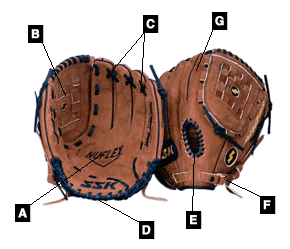|
| |
Buying A Baseball Glove
by Chris Greco, Sr. |
Go to any sporting goods store and
you'll find racks and racks of baseball gloves and very little information on how to
choose the right one. This article is designed to help you choose the one that's
right for you. It's more than just finding a glove that looks good. It's all
about finding a glove that fits your ability and playing style as well as your hand.Features...
The Pocket - Should not be too
deep. Especially for infielders who need to transfer the ball quickly.
The Webbing - There a few different
styles including closed webbing which can't be seen through and open webs which are
preferred by outfielders and third-baseman.
 |
Lacing - It's simple the
less lacing, the less chance the glove will fall apart.
Padding - The
thicker the more comfort.
Back - Open backs have an
open space above the wrist band. Closed backs only have a finger hole. Open
backs break in more quickly and are preferred by middle infielders.
|
- Wrist Adjustment - Look for the ability
to adjust the wrist and back opening. Some gloves have D-rings or other band
fasteners. Stay away from Velcro-type fasteners since they wear out quickly.
- Leather - The better the quality the
longer the glove will last. Avoid plastic or imitation leather.
What You Need To Know...
- What Position
Do You Play? - Adults should pick a glove that is designed for the position you
play the most. Since younger players are usually still learning different positions
the best choice may be a infielder's glove.
- What Is Your
Price Range? - A more expensive glove is usually made of better
material and better constructed. Remember, set a spending limit and find the best
glove in that price range.
- How Often Do You
Play? - The more you play, the more you may want to invest.
Youth Sizes...
For All Youth:
Find a glove that fits well. Don't pick a glove that your child will
"grow into". The proper size will help your child learn his/her position
properly.
8 - 12 Years Old:
These gloves should be no bigger than 12 inches. Kids 8 and older can try
gloves in the 11s. Younger or small kids should use gloves in the 9 to 11 inch
range.
High School
Age:
Select a full size or lower end adult glove. This glove should be designed for your
position.
Adult Sizes...
| Position |
Size |
Pocket Size |
| Outfield |
12 to 12 3/4
inches |
Has larger
pocket. |
| Infield |
10 3/4 to 11
3/4 inches |
Smaller pocket
for quick transfer from glove to hand. |
| Pitcher |
11 3/4 to 12
1/4 inches |
Smaller pocket
for good transfer. |
TOP
Also See: Breaking In A New Glove
|
|
